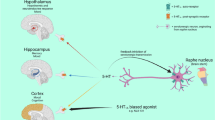Summary
A range of D1 receptor agonists were tested for their ability to facilitate limbic motor seizures induced by a subthreshold dose of the chemoconvulsant pilocarpine (100 mg/kg IP) in mice. ED50 values (μmol/kg) were calculated from log dose-probit analyses, giving relative proconvulsant potencies of SKF 82958>CY 208-243>SKF 77434=SKF 75670=SKF 80723>SKF 38393. The compound SKF 82526, which poorly crosses the blood-brain barrier, did not lower the seizure threshold. Convulsions consisted of rearing and forepaw myoclonus, leading to status epilepticus at higher doses of the D1 agonists. No deaths were recorded. A maximum seizure incidence of 50% was obtained with SKF 75670, compared to 100% for the other compounds. Apart from SKF 82526, the D1 agonists all elicited behavioural signs of central D1 receptor stimulation, including motor restlessness, grooming and sniffing. There was no obvious relationship between the abilities of these D1 agonist drugs to promote epilepsy and their effects on unconditioned motor behaviour, or their affinities and efficacies at the striatal D1 receptor. It is concluded that a reduction of the seizure threshold is an inevitable consequence of central D1 receptor stimulation with existing D1 agonists.
Similar content being viewed by others
References
Abbott B, Starr BS, Starr MS (1991) CY 208-243 behaves as a typical D-1 agonist in the reserpine-treated mouse. Pharmacol Biochem Behav 38: 259–263
Alam AM, Starr MS (1992) Dopaminergic modulation of pilocarpine-induced motor seizures in the rat: the role of hippocampal D1 receptors. Eur J Pharmacol 222: 227–232
Al-Tajir G, Starr MS (1990) Anticonvulsant action of SCH 23390 in the striatum of the rat. Eur J Pharmacol 191: 329–336
Al-Tajir G, Starr MS (1991) D-2 agonists protect rodents against pilocarpine-induced convulsions by stimulating D-2 receptors in the striatum, but not in substantia nigra. Pharmacol Biochem Behav 39: 109–113
Al-Tajir G, Chandler CJ, Starr BS, Starr MS (1990a) Opposite effects of stimulation of D1 and D2 dopamine receptors on the expression of motor seizures in mouse and rat. Neuropharmacology 29: 657–661
Al-Tajir G, Starr MS, Starr BS (1990b) Proconvulsant effect of SKF 38393 mediated by nigral D1 receptors. Eur J Pharmacol 182: 245–251
Andersen PH, Jansen JA (1990) Dopamine receptor agonists: selectivity and dopamine D1 receptor efficacy. Eur J Pharmacol (Mol Pharmacol) 188: 335–347
Arnt J, Hyttel J, Sanchez C (1992) Partial and full dopamine D1 receptor agonists in mice and rats: relation between behavioural effects and stimulation of adenylate cyclase activity in vitro. Eur J Pharmacol 213: 259–267
Barone P, Parashos SA, Palma V, Marin C, Campanella G, Close TN (1990) Dopamine D1 receptor modulation of pilocarpine-induced convulsions. Neuroscience 34: 209–217
Barone P, Palma V, DeBartolomeis A, Tedeschi E, Muscettola G, Campanella G (1991) Dopamine D1 and D2 receptors mediate opposite functions in seizures induced by lithium-pilocarpine. Eur J Pharmacol 195: 157–162
Burke K, Chandler CJ, Starr BS, Starr MS (1990) Seizure promotion and protection by D-1 and D-2 dopaminergic drugs in the mouse. Pharmacol Biochem Behav 36: 729–733
Clark D, White FJ (1987) D` dopamine receptor—the search for a function: a critical evaluation of the D1/D2 dopamine receptor classification and its functional implications. Synapse 1: 347–388
Close SP, Marriott AS, Pay S (1985) Failure of SKF 38393-A to relieve parkinsonian symptoms induced by 1-methyl-4-phenyl-1,2,3,6-tetrahydropyridine in the marmoset. Br J Pharmacol 85: 320–322
Hahn RA, Wardell JR, Sarau HM, Ridley PT (1982) Characterization of the peripheral and central effects of SK&F 82526, a novel dopamine receptor agonist. J Pharmacol Exp Ther 223: 305–313
Kresch MJ, Shaywitz BA, Shaywitz SE, Anderson GM, Leckman JL, Cohen DJ (1987) Neurotransmitters in human epilepsy. In: Jobe PC, Laird HE (eds) Neurotransmitters and epilepsy. Humana Press, New York, pp 321–338
La Grutta V, Sabatino M (1990) Substantia nigra-mediated anticonvulsant action: possible role of a dopaminergic component. Brain Res 515: 87–93
Löscher W, Czuczwar SJ (1986) Studies on the involvement of dopamine D-1 and D-2 receptors in the anticonvulsant effect of dopamine agonists in various rodent models of epilepsy. Eur J Pharmacol 128: 55–65
Markstein R, Seiler MP, Vigouret JM, Urwyler S, Enz A, Dixon K (1988) Pharmacologic properties of CY 208-243, a novel D1 agonist. In: Dahlström A, Sandler M, Belmaker RH (eds) Progress in catecholamine research, part B. Central aspects. Alan Liss, New York, pp 59–64
Molloy AG, Waddington JL (1987) Assessment of grooming and other behavioural responses to the D-1 dopamine receptor agonist SK&F 38393 and its R- and S-enantiomers in the intact adult rat. Psychopharmacology 92: 164–168
Murray AM, Waddington JL (1989) The induction of grooming and vacuous chewing by a series of selective D-1 dopamine receptor agonists: two directions of D-1: D-2 interaction. Eur J Pharmacol 160: 377–384
Murray AM, Waddington JL (1990) New putative selective agonists at the D-1 dopamine receptor: behavioural and neurochemical comparison of CY 208-243 with SK&F 101384 and SK&F 103243. Pharmacol Biochem Behav 35: 105–110
O'Boyle KM, Waddington JL (1985) Structural determinants of selective affinity for brain D-1 dopamine receptors within a series of 1-phenyl-1H-3-benzazepine analogues of SK&F 38393 and SCH 23390. Eur J Pharmacol 115: 291–295
O'Boyle KM, Gaitanopoulos DE, Brenner M, Waddington JL (1989) Agonist and antagonist properties of benzazepine and thienopyridine derivatives at the D1 dopamine receptor. Neuropharmacology 28: 405–411
Setler P, Sarau HM, Zirkle CL, Saunders HL (1978) The central effects of novel dopamine agonist. Eur J Pharmacol 50: 419–430
Turski WA, Cavalheiro EA, Ikonomidou C, Bortolotto ZA, Klockgether T, Turski L (1990) Dopamine control of seizure propagation: intranigral dopamine D1 agonist SKF 38393 enhances susceptibility to seizures. Synapse 5: 113–119
Wahnschaffe U, Löscher W (1991) Anticonvulsant effects of ipsilateral but not contralateral microinjections of the dopamine D2 agonist LY 171555 into the nucleus accumbens of amygdala-kindled rats. Brain Res 553: 181–187
Author information
Authors and Affiliations
Rights and permissions
About this article
Cite this article
Starr, M.S., Starr, B.S. Seizure promotion by D1 agonists does not correlate with other dopaminergic properties. J Neural Transm Gen Sect 6, 27–34 (1993). https://doi.org/10.1007/BF02252620
Received:
Accepted:
Issue Date:
DOI: https://doi.org/10.1007/BF02252620




